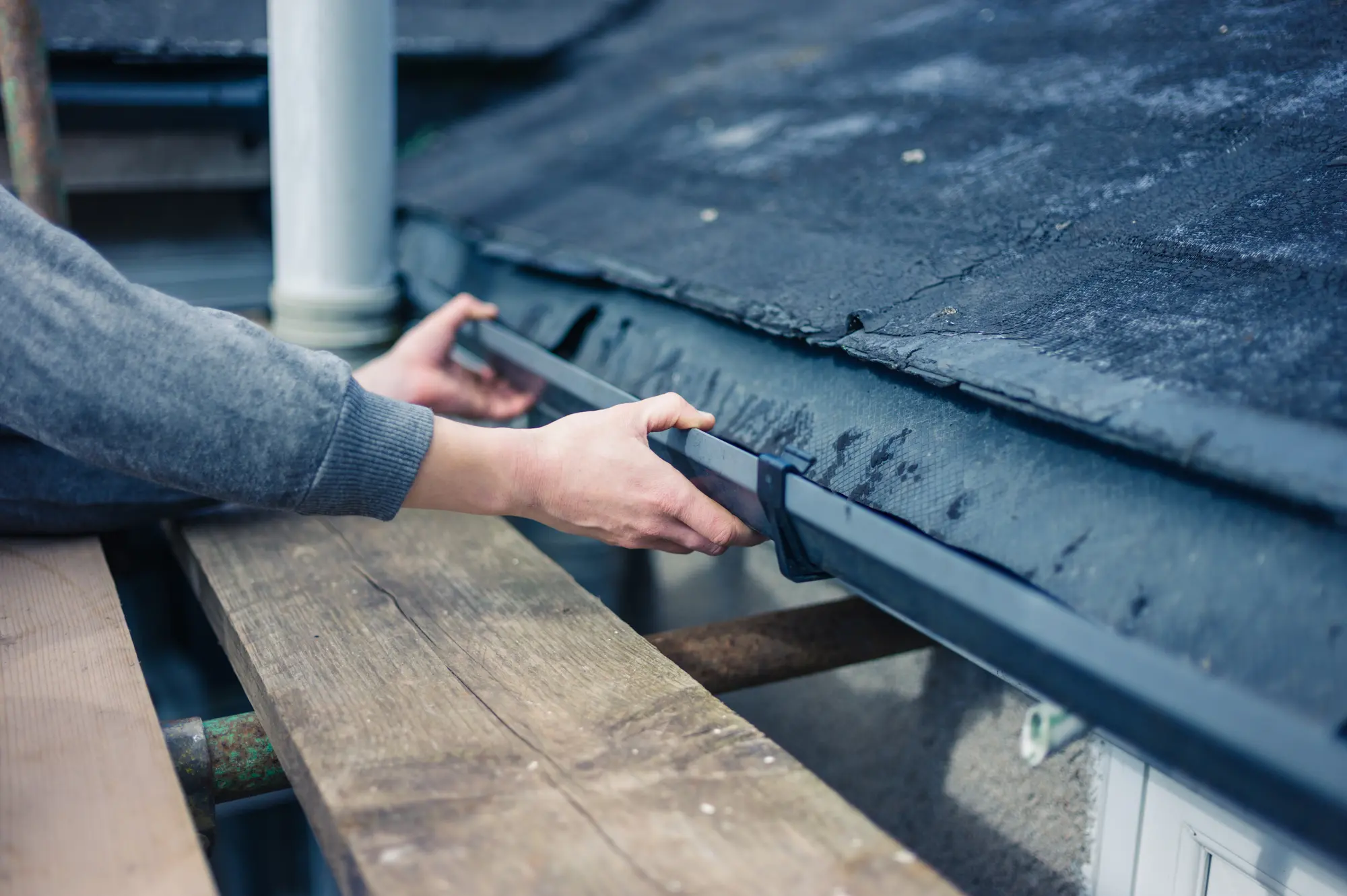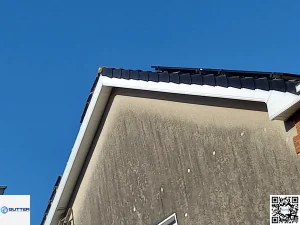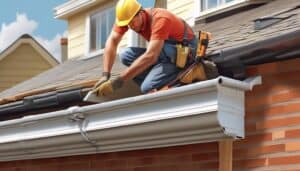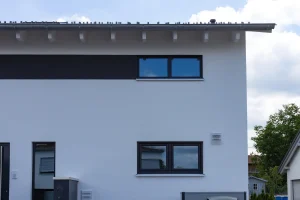Gutters are the unsung heroes of your home, keeping it safe from water damage. But for them to do their job right, they’ve got to be lined up and levelled just right.
Make sure your gutters are properly aligned and levelled. This is key to ensuring they drain water effectively and protect your property. This isn’t just something for homeowners to know – if you’re a pro contractor, these tips and tricks will be handy for you too.
We’ll talk about how to spot gutter alignment issues and which tools and materials can help you out. So, if you want to make sure that rainwater is being efficiently directed away from your home, then this is the place for you. Let’s discuss the tips for aligning and levelling gutters to get them in tip-top shape.
Key Takeaways
-
Gutters are essential for protecting homes from water damage and should be aligned and levelled correctly to function properly.
-
Alignment issues in gutters can result from blocked gutters, worn-out hangers, and incorrect slopes, leading to sagging, leaks, and water damage.
-
Regular gutter maintenance, including cleaning and inspection, is crucial in preventing alignment problems and extending the lifespan of the gutter system.
-
Tools like cordless screwdrivers, spirit levels, hacksaws, and materials such as gutter sections and brackets are needed for aligning and levelling gutters.
-
Maintaining proper gutter alignment is vital for the overall health of a home and the prevention of costly repairs, including foundation issues and water damage.
What Are Common Gutter Alignment Issues?
Gutter alignment problems are quite common and often result from issues such as blocked gutters, worn-out hangers, and gutters that are incorrectly sloped. These problems, if not fixed promptly, can lead to a variety of other complications such as sagging, leaks, and water damage.
One of the most frequent culprits of gutter alignment troubles is blocked gutters. Debris like leaves, twigs, and dirt can accumulate in the gutters, making them heavy and leading to sagging. This added weight can also pull the gutters away from the fascia, further exacerbating alignment issues. A good practice is to regularly clean and maintain your gutters to avert this sort of damage.
Worn-out hangers or fasteners that are too far apart can also result in gutter alignment problems. The hangers that keep the gutters in place can deteriorate over time, causing the gutters to sag or separate from the house. A simple fix for this is to replace the old hangers and make sure they’re properly secured.
Gutters that are incorrectly sloped can also lead to alignment problems. If the gutters aren’t sloped just right, the water may not flow toward the downspouts as it should, causing pooling and potential leaks. A good solution to this problem is to measure, mark with a chalk line, and then realign the gutter for proper water flow. This can help prevent damage from occurring.
Should Gutters Be Level?
No, gutters should not be perfectly level. They need a slight slope to direct rainwater towards the downspouts. Typically, gutters should slope about 0.25 to 0.5 inches for every 10 feet. This ensures water flows efficiently and prevents accumulation. This can cause overflow, rusting, and damage to your home’s foundation and landscaping.
To measure the slope, start at the highest point of the gutter, farthest from the downspout. Mark this point and measure 10 feet along the gutter. Use a string and a level to check that the lower end is 0.25 to 0.5 inches below the higher mark. Repeat in segments until reaching the downspout.
Adjust the slope by repositioning the hangers. Loosen the screws, reposition the hangers to achieve the correct pitch, and secure them. Ensure the pitch is consistent along the gutter’s length for efficient water flow.
What Tools and Materials Are Needed?
If you’re dealing with crooked gutters, worn hangers, or a problematic gutter slope, don’t worry – these are pretty common issues. They can be fixed with a few specific gutter tools and materials. It’s also a good reminder that regular gutter upkeep is key to keeping these little problems at bay and extending the lifespan of your gutter system.
One tool to use is a cordless screwdriver or drill, which is used to fasten the gutter brackets or fascia brackets. A spirit level is also critical for making sure the gutters are level and have the right slope. Then there’s a hacksaw, which is great for cutting gutter sections down to the right size. Don’t forget a pencil to mark out the spacing for the gutter brackets and other parts. To make the installation process go more smoothly, you could use a silicone lubricant.
Safety is a key concern when working high up, so be sure to have ladders and some string to secure them.
And let’s not forget about the materials you’ll need. This includes round guttering sections, running outlet or stop-end gutter outlets, gutter brackets or fascia brackets, gutter union pieces, and external stop-ends.
Now, gutters come in different materials like aluminium, vinyl, and steel, each with its own set of benefits and drawbacks. Aluminium gutters are light and won’t rust.
Vinyl gutters are easy on the wallet and simple to install. Steel gutters are sturdy but can rust if not taken care of.
How to Realign Gutters?
To realign your gutter, start by taking a good look at your gutters. If you notice any sagging, water gathering in one spot, or water spilling over the sides, it’s likely that your gutters aren’t aligned as they should be.
Next, grab a chalk line and measure the slope of your gutters. For optimal water flow, you’d want a slope of about a quarter inch for every 10 feet of gutter.
Once that’s done, it’s time for some cleaning. Remove any debris from your gutters to prevent them from sagging and also check on your brackets. They should be evenly spaced and fastened securely to maintain the alignment of your gutters.
If you find any loose gutters during your inspection, don’t panic. You can realign them using new brackets or fascia boards to make sure they’re secure and properly aligned.
And here’s a pro tip: consider installing gutter extensions. These handy tools discharge water well beyond your home’s foundation. This can prevent any potential water damage.
For realignment, locate the hangers securing the gutter. Loosen the hangers, adjust the gutter to the correct slope, and re-secure the hangers. Ensure a consistent slope along the gutter’s length.
Keeping your gutters properly aligned is crucial for the overall health of your home. If you let gutter maintenance slide, you could end up with water damage, foundation troubles, and a hefty repair bill. But by following this simple and easy guide, you can keep your gutters in great shape and working perfectly.
What Are the Tips for Leveling Gutters?
If you’re looking to keep your gutters in tip-top shape, here are some handy pointers. Let’s start with the basics – gutter maintenance should be a regular part of your home care routine. Prevent any unwanted blockages or buildup of debris by keeping them clean. This helps to keep the water flowing freely and efficiently.
Next up, keep a close eye on your gutters. A sagging gutter is a sign you don’t want to ignore. It can be due to a buildup of debris or simply a lack of support from the brackets. If you spot any sagging, don’t delay addressing it, because it could lead to more serious problems down the line. You might have to replace parts of the gutter or reinforce it with some extra brackets.
To sum it all up, let’s break down these key points:
- Identify the Highest Point: Attach the gutter at the highest possible point on the fascia to ensure efficient water flow towards the downspout.
- Check the Slope: Use a 2-foot or 4-foot level to verify the slope. The bubble should be on the line toward the high point for the correct incline.
- Proper Drainage: Maintain a gentle slope of about two inches for every 40 feet to ensure proper drainage without overflow.
- Install Fasteners: Place fasteners every six feet to keep a consistent slope. Reattach brackets with new fixings if gutters are pulling away from the roof or walls.
- Professional Help: Hire a professional for precise realignment and secure attachment. This will ensure the longevity and effectiveness of the gutter system.
Frequently Asked Questions
What Is the Proper Slope for a Gutter?
Gutters should have a slope between 0.25 and 0.5 inches for every 10 feet in length. This ensures efficient water drainage toward the downspouts, preventing overflow and pooling.
Gutters should not be flat. A slight incline prevents water accumulation and blockages. An overly steep angle can cause water to rush too quickly, potentially overshooting the downspout.
How To Fix Uneven Gutters
- Assess the Incline: Locate the highest point of the gutter farthest from the downspout. Measure every 10 feet along the gutter, ensuring a drop of 0.25 to 0.5 inches.
- Adjust Hangers: Identify and loosen the screws or unhook the hangers. Reposition them to achieve the proper incline. Secure the hangers by drilling new holes if necessary or tightening the screws.
- Seal the Seams: Apply silicone caulk to the interior seams where different sections meet to prevent leaks.
- Test the System: Pour water into the gutters and observe the flow. Ensure the water moves consistently toward the downspout without pooling or leaking.
Should There Be a Gap Between Fascia and Gutter?
Yes, there should be a minimal gap between the fascia and the gutter. This gap allows for proper water drainage and ventilation. This prevents water infiltration and potential damage.
The ideal gap should be narrow enough to stop water from seeping behind the gutter but wide enough to ensure adequate airflow. This ventilation aids in drying any moisture, protecting the fascia and roofline from long-term damage.
How Far Should a Gutter Be From the Roof?
Gutters should be installed no more than 2 to 3 inches from the roof edge for efficient water drainage. This ensures rainwater flows directly into the channels rather than overshooting, preventing soil erosion and foundation damage.
When gutters are too far from the roof edge, they may not capture all runoff, leading to frequent gutter level adjustments and potential repairs. Improper placement can also affect the overall alignment of the gutter system.
How To Level a Gutter That is Sagging?
The key is to get the gutter pitch just right. You might need to tweak the hangers a bit or add some extra support to make sure the water can flow freely and to keep the whole system from getting damaged.








